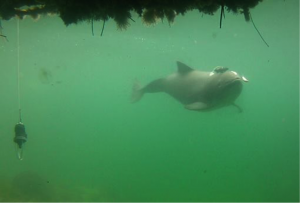Diving physiology and energetics of cetaceans (in collaboration with Drs. Peter Madsen, Mark Johnson, and Natacha Aguilar de Soto)
 Cetaceans are among the largest animals ever to evolve, and as apex predators in marine ecosystems, they have a significant top-down effect on prey targeted during long, deep breath-hold dives. It is therefore essential to understand the energetic requirements and oxygen management of cetaceans if we are to interpret and understand their role in the trophic energy cascades, their foraging ecology, limits of dive performance and ability to adapt to environmental change and disturbance. However, very little is known about the field physiology of cetaceans due their size and hostile habitats. At the Fjord and Bælt center (Kerteminde, Denmark) a unique opportunity exists to measure metabolic rate, heart rate, and activity in captive porpoises that live in a large net pen experiencing similar conditions to wild porpoises. By having access to this one of a kind facility, we will be able to compare these data on captive porpoises to heart rate and activity data of wild porpoises in the same Danish waters. This provides a unique opportunity to examine the field energetics and diving physiology of a wild cetacean.
Cetaceans are among the largest animals ever to evolve, and as apex predators in marine ecosystems, they have a significant top-down effect on prey targeted during long, deep breath-hold dives. It is therefore essential to understand the energetic requirements and oxygen management of cetaceans if we are to interpret and understand their role in the trophic energy cascades, their foraging ecology, limits of dive performance and ability to adapt to environmental change and disturbance. However, very little is known about the field physiology of cetaceans due their size and hostile habitats. At the Fjord and Bælt center (Kerteminde, Denmark) a unique opportunity exists to measure metabolic rate, heart rate, and activity in captive porpoises that live in a large net pen experiencing similar conditions to wild porpoises. By having access to this one of a kind facility, we will be able to compare these data on captive porpoises to heart rate and activity data of wild porpoises in the same Danish waters. This provides a unique opportunity to examine the field energetics and diving physiology of a wild cetacean.
We have recently received funding from the Office of Naval Research (ONR) to continue this line of research. We will continue to develop the data logging technology we used on the porpoises for use on larger cetacean such as pilot whales and beaked whales.

